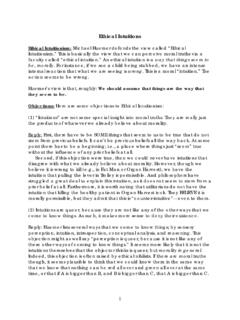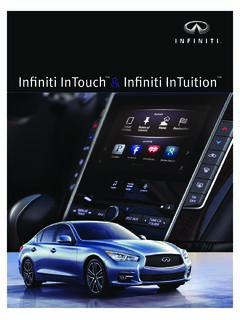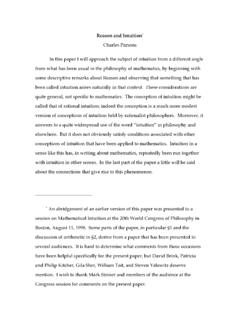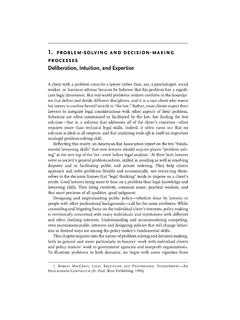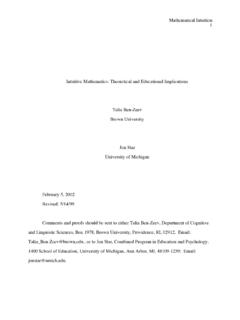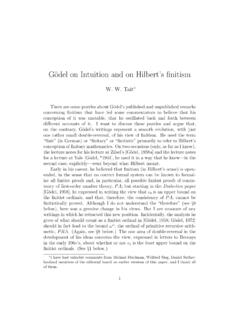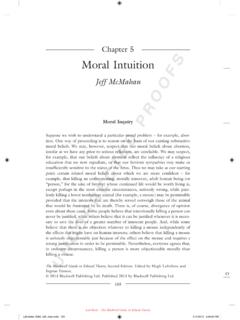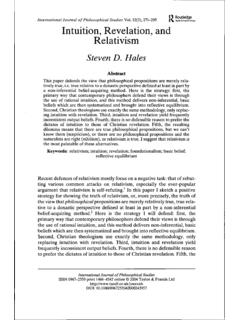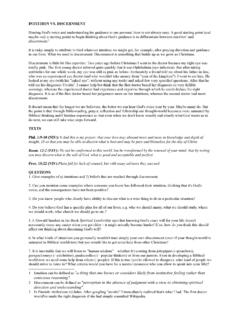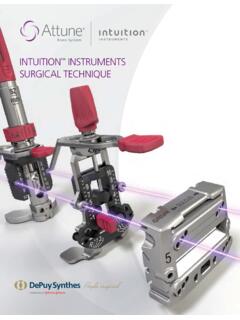Transcription of INTUITION: WHAT SCIENCE SAYS (SO FAR) ABOUT HOW …
1 [Published in the book, Endophysics, Time, Quantum and the Subjective, edited by Rosolino Buccheri et al., World Scientific Publishing, Singapore, 2005]. intuition : what SCIENCE says (SO FAR) ABOUT HOW AND WHY intuition WORKS PAUL BERNSTEIN, Educational Services, 8 Ferry Street Chelsea, Massachusetts 02150, United States Abstract: intuition is defined for the purposes of this analysis as: the appearance in the mind of accurate information ABOUT the external world, which can be shown to have come not through the five senses, nor through a rearrangement of stored memory contents.
2 Forms of intuition obeying this definition have been explored scientifically under such labels as telepathy, precognition, presentiment, and remote viewing. This paper summarizes those scientific findings, and presents a few theories which have been hypothesized to explain them. Those theories are largely based in theoretical physics, including quantum non-locality, holography, and complex space-time. Related biological theories are also cited, which propose to explain how information might move from the subatomic level up into waking consciousness, for example through DNA structures or neuronal microtubules.
3 Keywords: Telepathy Precognition Quantum Hologram Space-time 1 Introduction Probably all of us can recall occasions when we ve had a strong hunch or intimation ABOUT some person or event. Most often it came as a quick flash of information perhaps ABOUT a person s trustworthiness, or ABOUT an impending event s danger or success. This morsel of information was not a conclusion we d arrived at after lengthy, rational cogitation, assessing evidence we d gathered deliberately over a long period of time. Nevertheless, the flash turned out to be true which, ironically, may then have engendered a conflict of feelings within us.
4 For on the one hand, we were pleased to find ourselves right ABOUT the person or the future event. But on the other hand, we may have felt troubled, because we didn t know how we d gotten that accurate information, and therefore we weren t sure how to summon up the ability again in the future or even, whether to trust it. Consequently, we may have decided to dismiss the episode as a chance coincidence, and decided that it did not really constitute a reliable way to acquire accurate information. But what if SCIENCE were to study such occasions of hunches , monitoring them under controlled laboratory conditions, counting the number of accurate and 2 intuition : what SCIENCE says (So Far) ABOUT How and Why intuition Works inaccurate flashes ?
5 Would the results equal chance thereby demonstrating that indeed, such occasions of accuracy are merely coincidence? Or would the experiments reveal that persons experience such accuracy at rates significantly greater or less than chance? And if they occur more often than chance, could the scientific method help us learn how and why they occur? 2 Findings For at least 100 years, scientists have in fact been studying forms of intuition under controlled, laboratory conditions [1]. By intuition , for the purposes of scientific study, we mean: the appearance of accurate information in the mind of an individual, concerning events, persons or locales outside that individual, which can be shown to have come not through the five senses, nor through a rearrangement of the individual s stored memory contents.
6 This definition is faithful both to our common subjective experience of intuition and to our scientific need for operationalizing a phenomenon in order to subject it to controlled research [2].a In practice, this definition includes three types of intuition that scientists have tried to study: (i) information which we gain from another person (informally called telepathy ) (ii) information which we gain ABOUT another place or object (sometimes called remote viewing or clairvoyance ) (iii) information which we gain ABOUT the future (which for scientific purposes is divided into precognition [thoughts] and presentiment [feelings]).
7 The next three sections review the research that has been attempted in each of these areas (and has been published in the English language). Research on telepathy (person-to-person transmission) Beginning in 1927, Prof. Joseph Rhine conducted laboratory experiments at Duke University in North Carolina (USA), in which one person would select a card from a well-shuffled deck and would mentally concentrate on its image while another person some distance away would note down the image that a Broader than this definition is the common usage of intuition to mean realizations that do come from stored memory contents as when an artist or scientist at first gives up consciously trying to solve a particular creative problem and then a day or two later.
8 Thinks of a solution while doing something else taking a walk, a shower, or in a dream. That is a process of creativity, and is worthy of scientific study in its own right. But it is distinct from the acquisition of information that exists originally outside the individual s mind, such as items perceived through forms of intuition known as precognition or remote viewing. Paul Bernstein 3 appeared in his or her mind. Dr. Rhine and his colleagues used a set of 25 cards designed especially for this purpose. Each card contained a simple symbol: circle, square, star, etc.
9 In a series of experiments spreading over the following 13 years, they accomplished almost one million trials. Twenty-seven of those 33 studies produced statistically significant results; that is, the receiver or guesser correctly identified the card being viewed by the sender at rates greater than chance. Colleagues at other institutions began to replicate Rhine s procedure, and 61% of those other laboratories replication experiments also yielded statistically significant results whereas only 5% would have been expected by chance [3]. A different laboratory method for testing person-to-person transmission was created by Dr.
10 Charles Tart working at the Massachusetts Institute of Technology (USA) in 1963. Instead of asking a receiver to record an image appearing in his mind while a sender gazed at a card, Tart measured the bodily reactions of the receiver when a stimulus was applied to the body of the sender. (Let us recall that the root meaning of tele-pathy is feeling [pathos] at a distance [tele] ). The two individuals were located in separate rooms. To ascertain the receivers bodily responses, Tart monitored their brain waves, finger pulse blood volume, and skin electrical conductance, and found that the first two, brain waves and peripheral blood volume, changed significantly when the stimulus was engaged at or near the sender (Table 1) [4].
